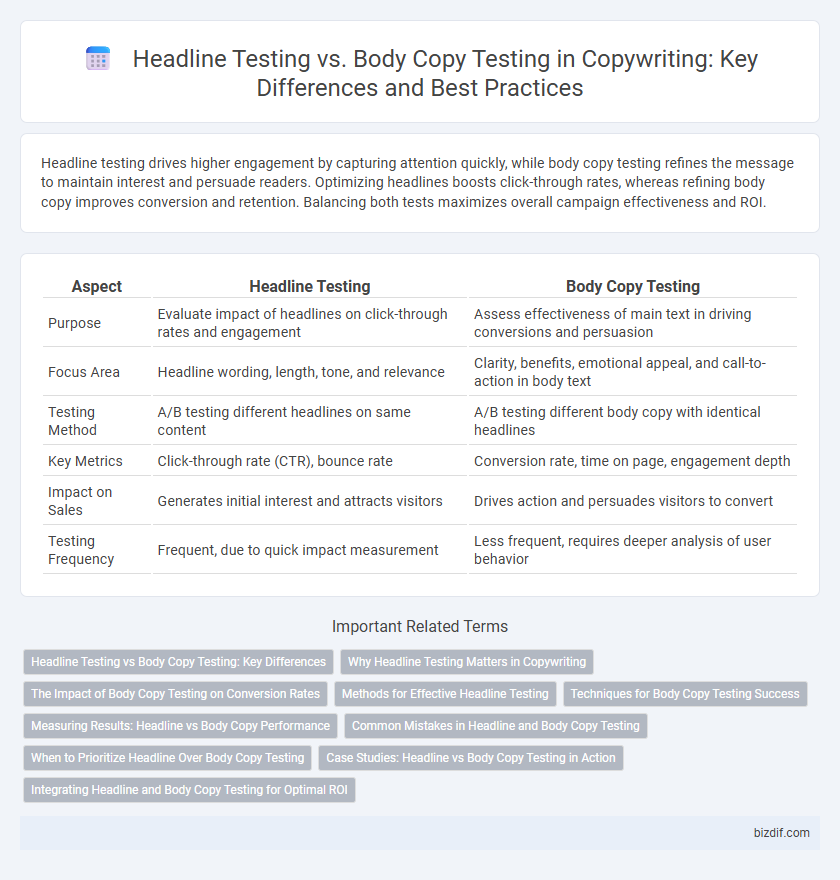Headline testing drives higher engagement by capturing attention quickly, while body copy testing refines the message to maintain interest and persuade readers. Optimizing headlines boosts click-through rates, whereas refining body copy improves conversion and retention. Balancing both tests maximizes overall campaign effectiveness and ROI.
Table of Comparison
| Aspect | Headline Testing | Body Copy Testing |
|---|---|---|
| Purpose | Evaluate impact of headlines on click-through rates and engagement | Assess effectiveness of main text in driving conversions and persuasion |
| Focus Area | Headline wording, length, tone, and relevance | Clarity, benefits, emotional appeal, and call-to-action in body text |
| Testing Method | A/B testing different headlines on same content | A/B testing different body copy with identical headlines |
| Key Metrics | Click-through rate (CTR), bounce rate | Conversion rate, time on page, engagement depth |
| Impact on Sales | Generates initial interest and attracts visitors | Drives action and persuades visitors to convert |
| Testing Frequency | Frequent, due to quick impact measurement | Less frequent, requires deeper analysis of user behavior |
Headline Testing vs Body Copy Testing: Key Differences
Headline testing evaluates the effectiveness of various headline options by measuring click-through rates and initial engagement, as headlines play a pivotal role in capturing attention. Body copy testing focuses on different versions of the main content to optimize readability, persuasion, and conversion rates through detailed user response analysis. Key differences lie in their impact phase--headlines drive first impressions and traffic, while body copy influences deeper engagement and final conversions.
Why Headline Testing Matters in Copywriting
Headline testing is crucial in copywriting because headlines serve as the primary hook that captures reader attention and drives engagement. Effective headline testing increases click-through rates by identifying the most compelling language, tone, and keywords that resonate with the target audience. Optimizing headlines through A/B testing significantly enhances overall campaign performance by improving visibility and conversion metrics.
The Impact of Body Copy Testing on Conversion Rates
Testing body copy directly influences conversion rates by refining the message's clarity, relevance, and emotional appeal to the target audience. Data-driven adjustments to body copy can reveal which phrasing and information drive higher engagement, trust, and action. Optimized body copy consistently proves more effective at nurturing leads and sealing conversions than headline testing alone.
Methods for Effective Headline Testing
Effective headline testing leverages A/B testing to compare multiple headline variations, measuring click-through rates and engagement metrics directly tied to user behavior. Implementing multivariate testing can further isolate the impact of headline elements such as word choice, length, and emotional appeal, optimizing for maximum reader attention. Utilizing heatmaps and eye-tracking data enhances understanding of visual focus patterns, ensuring headlines capture immediate interest within digital content layouts.
Techniques for Body Copy Testing Success
Effective body copy testing relies on techniques such as A/B testing different versions of paragraphs or sentences to measure engagement and conversion rates. Utilizing heatmaps and scroll tracking tools reveals which parts of the copy capture the reader's attention and prompt action. Employing user feedback surveys and analyzing readability scores further refines the persuasive power of body copy, enhancing overall campaign performance.
Measuring Results: Headline vs Body Copy Performance
Headline testing often yields immediate insights into click-through rates and user engagement due to its direct influence on attention and interest. Body copy testing provides deeper understanding of conversion rates and customer retention by evaluating message clarity, emotional appeal, and persuasive elements throughout the content. Analyzing data from both headline and body copy tests enables more precise optimization of marketing material, improving overall campaign effectiveness.
Common Mistakes in Headline and Body Copy Testing
Common mistakes in headline testing include relying solely on click-through rates without measuring conversion impact or ignoring audience segmentation, leading to misleading results. In body copy testing, errors often involve testing multiple elements simultaneously, which confounds data interpretation, and neglecting the alignment between body copy and headline, reducing overall message effectiveness. Both headline and body copy testing demand precise hypothesis framing and sufficient sample sizes to avoid statistical insignificance and ensure actionable insights.
When to Prioritize Headline Over Body Copy Testing
Headline testing should be prioritized when initial user engagement metrics like click-through rates and bounce rates indicate weak attention capture. Effective headlines are critical for driving traffic and setting expectations, so testing them early can significantly impact conversion rates. Body copy testing becomes more valuable once the headline successfully attracts the audience and the focus shifts to optimizing message clarity and persuasion.
Case Studies: Headline vs Body Copy Testing in Action
Case studies reveal that headline testing drives higher engagement rates by capturing initial attention, while body copy testing enhances conversion by refining message clarity and relevance. Data from A/B tests show headlines can increase click-through rates by up to 50%, whereas optimized body copy boosts overall sales performance by 20-30%. Effective copywriting strategies combine rigorous headline experimentation with targeted body copy adjustments to maximize campaign ROI.
Integrating Headline and Body Copy Testing for Optimal ROI
Integrating headline and body copy testing maximizes ROI by aligning attention-grabbing headlines with persuasive, conversion-driven body content. Testing headlines alone may increase initial clicks, but coupling it with body copy experimentation ensures sustained engagement and higher conversion rates. Leveraging A/B tests that evaluate both elements concurrently provides actionable insights to optimize messaging strategy effectively.
Headline Testing vs Body Copy Testing Infographic

 bizdif.com
bizdif.com